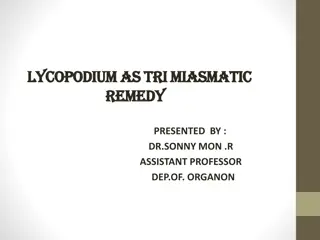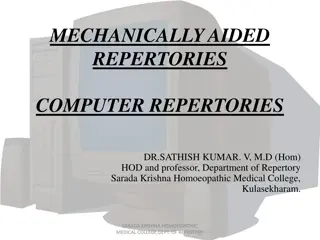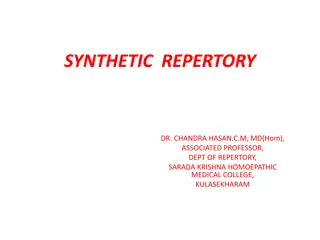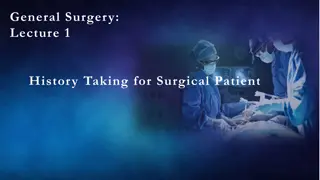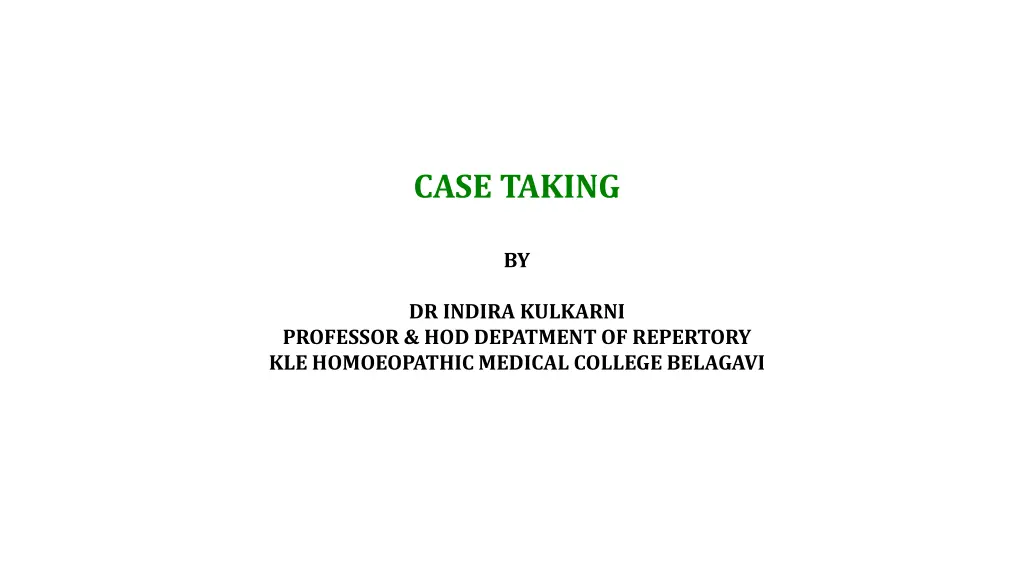
Understanding Case Taking Process in Homeopathy
Explore the intricate process of case taking in Homeopathy, where healthcare professionals gather vital patient information to identify suitable remedies. Learn about the objectives, patient expectations, dealing with difficult patients, and the role of physicians in this unique art of diagnosis and treatment.
Uploaded on | 3 Views
Download Presentation

Please find below an Image/Link to download the presentation.
The content on the website is provided AS IS for your information and personal use only. It may not be sold, licensed, or shared on other websites without obtaining consent from the author. If you encounter any issues during the download, it is possible that the publisher has removed the file from their server.
You are allowed to download the files provided on this website for personal or commercial use, subject to the condition that they are used lawfully. All files are the property of their respective owners.
The content on the website is provided AS IS for your information and personal use only. It may not be sold, licensed, or shared on other websites without obtaining consent from the author.
E N D
Presentation Transcript
CASE TAKING BY DR INDIRA KULKARNI PROFESSOR & HOD DEPATMENT OF REPERTORY KLE HOMOEOPATHIC MEDICAL COLLEGE BELAGAVI
DEFINITION: A case presentation/ taking is a formal communication between a health care professional doctors, nurses, therapists, nutritionists etc) regarding a patient s clinical information. Essential parts of the case taking includes, identification, reason for consultation/ OPD or IPD admission. Case taking is the process of collecting information, using various tools like observation, perception, history taking given by the patient/attendant, clinical examination etc. in order to find out the suitable remedy for the patient using knowledge of Homeopathic materia-medica, organon and repertory. Case taking is a unique art of receiving information from the patient as well as from bystanders to define the patient as a person and to diagnose the disease.
Objectives Of Case Taking 1. To understand the patient and his/her surroundings. 2. To define the problem of the person 3. To understand the disease of the person with the common and characteristic symptoms. 4. To attempt problem resolution and effective counseling. 5. To manage the case on auxiliary, general and specific levels. 6. To help the patient to realize his problem so that he/she can ventilate it ( emotional unloading). 7. Finally to find out the constitutional, intercurrent and acute totalities so that the respective remedies could be selected.
Who is a patient??????????? The person who needs help .. Common questions in patient s mind 1. Whether my condition is curable? 2. How can I find a good doctor? 3. How can I find a good doctor who can care about all my complaints and recover me of this problem? 4. Can I afford the treatment? Patient s expectations: 1. To listen to him/her. 2. Being non-judgmental about him/her. 3. To have the professional competency in medical science and technology. 4. To be reasonably informed as to the probable cause of his concern and what is the prognosis.
Difficult patient. 1.The violent patient 2.Manipulative patient 3.The patient who refuses treatment 4.The drunk 5.The patient with multiple somatic complaints 6.The goner ( dumped patient)
Who is a Physician???????????? 1. He is the master of the show. 2. The one who has chosen medicine as a career, and well aware of all the skills, recent developments in the medicine. 3. The one who has knowledge of technical skills, broad scientific knowledge. 4. To be a good physician one has to be the good human being first, being empathetic ( not to carried away with patient s emotions) physician has to remain neutral to patient s emotions & expressions. 5. The physician also should be a great learner.
Information vs Data 1. Clinical information can be obtained from three main sources other than laboratory and radiological findings. 2. The three sources are.. Patient himself physician s observation physical examination. 3. Data is a group of facts. 4. For e.g. a patient MN /58/M c/o weakness and breathlessness and his BP is 130/82 mm of Hg ( normal BP reading) who is a k/c/o HTN since 6 years and on medication. His BP readings last week was 180/110. ( this is data) 5. A Primigravida SK /24/F, c/o tingling numbness in head, both the upper extremities with 12 weeks pregnancy (information) her Hb reading at present 12gm%. 2 weeks back her Hb reading was 8gm% and a blood transfusion is done. 6. A case of cholelithiasis (information) of Mr GB /29/M usg readings abd & pelvis dated 22/03/21 2-3 mobile gall bladder calculi. His previous usg reading abd& pelvis dated 10/09/2020 was 5-6 mobile gall bladder calculi (data) 7. Information and Data both are having their own significance in treating the patient.
GENERAL PRINCIPLES OF CONVERSATION: 1. Case taking is not any mysterious process. It can be both taught and learned, it requires edge and skill. There are 3 main important aspects in case receiving. Recording a history, physical examination and laboratory investigations. 2. Always set up prior appointments as far as possible. Physician should be well dressed, make the patient comfortable both mentally and physically, have some casual conversation with the patient. 3. Interview the patient alone, relatives or attendants can be called at the appropriate time ( except psychiatric patients, h/o violent behavior etc) 4. Let the patient have freedom to express his/her complaints without any interruption. 5. Encourage the patient to use own words to express his complaints, politely discourage using of medical terms, diagnostic terms etc. 6. If any question of physician has made the patient uncomfortable then move on to next topic and once the patient develops confidence then touch the sensitive issues. 7. Avoid careless, haphazard conversations, asses the intellectual, emotional and social capabilities of the patient. 8. Use simple terms to define what is your diagnosis regarding patients illness, never frighten the patient explain the possibilities of differential diagnosis 9. Empathize patient s situation but try to keep your own anxieties, biases at side.
Physical examination: findings best defined by physical examination 1. Vital signs ( BP, PR, RR, Temp) 2. General appearance or general physical examination head to toe 3. Palpable lesions including masses, local tenderness, deformities, pulsations etc 4. Respiratory difficulties like gasping, cyanosis, signs of obstruction etc 5. Swellings of joints, discharges, wounds, ulcers etc 6. Murmurs, bruits, bowel sounds 7. Neurological signs 8. Systemic examination
Importance of Laboratory Investigations: 1. It helps in screening ( detection of disease) 2. Helps in confirming the suspected illness. 3. It also gives the idea regarding severity of the condition/ clinical situation. 4. It helps in monitoring the therapy by providing the amount of changes occurred before and after the Rx.
STANDRAD CASE RECORD 1. It has a frame work where in case can be recorded. It should be in such a way that it can accommodate all the information gathered during case taking. 2. Homoeopathic case record can be defined as a notebook or register which is used to enter all the data and information collected from the physician by the patient which can be of help in disease diagnosis, person diagnosis and remedy diagnosis & later to record the Rx. 3. An ideal case record should have the space for classification and analysis, totality formation according to Kent, Boger and Boenninghausen.
Method of working the case. 1. Recording section (case taking .very important) 2. Processing section 3. Prescription and follow up section
Structure of the standard case record Recording section : 1. Preliminary data 2. presenting complaints/ chief complaint 3. details of the presenting complaints 4. past history 5. family history 6. Personal History 7. life space investigation: cross section study and longitudinal section study 8. diagnosis : provisional, differential, final diagnosis
Processing section KENT S CONCEPT OF TOTALITY AND METHOD OF WORKING THE CASE Understanding Kent s Concept Of Totality . Man is prior to the organs .he believed in concept of treating the sick individualization He divided the symptoms in to Generals Common Mental generals Physical generals Particulars
Mind.. Will : anger, imitability, love, affection, hate, fear, grief, anxiety, sadness, weeping, mirth etc. Perversion of understanding: Hallucinations, illusions, delusions, dullness, comprehension, absorbed, engrossed, concentration difficult, exertion mental etc. Perversion of memory: Absent minded, forgetful, memory active, memory weak, mistakes in writing, speech difficulties etc.
Physical generals 1. Things affecting the entire body: diet, appetite, desires and aversions, bowels, micturition, perspiration, habits, hobbies, effects of weather changes, 2. Menstrual history and sexual history, effects of coition. 3. Constitution of the sick individual Particular symptoms: Characteristic particulars: Symptoms with Locations, Sensations and Modalities + concomitants. Common symptoms: which are common to disease conditions
Bogers Concept Of Totality Boenninghausen s Concept Of Totality Location Location Sensation Sensation Modalities < & > Modalities < & > Concomitants Concomitants He specifies 7 points in understanding the full picture of the disease. 1. Quis : Personality, the individuality 2. Quid: Disease its nature and peculiarity 3. Ubi:Seat of the disease 4. Quibus Auxilis: Accompanying symptoms 5. Cur : Cause of the disease 6. Quomodo: Modification, aggravation and amelioration 7. Quando :Time These seven points which are in the form of maxims contain al the aspects required to get a complete picture of the disease.
Processing section role of repertory starts here!!!!! Analysis, classification and evaluation of the of symptoms of the case. 1. A detailed study type of symptoms present in the case, classify them according to the concept of totality and give value to the symptom e. g. Desires for sweets++++, violent anger++++, yellow stools+, cramps in left calf++ etc 2. Form the totality or selecting symptoms for repertorisation. Symptoms selected for repertorisation Example: Symptoms kept in PDF Example: Violent anger, fear of snakes Desires sweets, scanty menstrual flow Loose yellow stools associated with lower abdomen cramps < spicy food, cold weather Hot patient, 3. Repertorial totality: This is Repertorial Totality Violent anger, fear of snakes Loose yellow stools associated with Lower abdomen cramps < spicy food, cold weather
Repertorisation : 1. Select the eliminating symptom ( the most important symptom taken from the reportorial totality) 2. Use repertory sheet and repertorise the case. Prescription and follow up: Choose the most similar remedy and select the follow up criteria for your case.
Importance of Record Keeping 1. A case record is collection of information and relevant data of the patient for future reference. 2. Well maintained case record leads to the development of a sound clinical acumen, furnishes the best possible material for clinical teaching and research and also provides reliable evidence. 3. Case record helps in diagnosis and treatment plan which helps in finding out the similimum to the case. 4. Record keeping helps in follow up of the case judiciously and scientifically. It helps in second prescription. 5. It helps in referring the case to other physician in case the patient migrates to another country or state. 6. Record keeping helps in research works on particular diseases and their treatment by using homeopathic medicines 7. Finally record speaks of the success and failure of the physician and guides for future.




